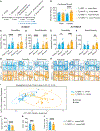Maternal gut microbiota mediate intergenerational effects of high-fat diet on descendant social behavior
- PMID: 36223744
- PMCID: PMC9597666
- DOI: 10.1016/j.celrep.2022.111461
Maternal gut microbiota mediate intergenerational effects of high-fat diet on descendant social behavior
Erratum in
-
Maternal gut microbiota mediate intergenerational effects of high-fat diet on descendant social behavior.Cell Rep. 2023 May 30;42(5):112498. doi: 10.1016/j.celrep.2023.112498. Epub 2023 May 2. Cell Rep. 2023. PMID: 37133995 Free PMC article. No abstract available.
Abstract
Dysbiosis of the maternal gut microbiome during pregnancy is associated with adverse neurodevelopmental outcomes. We previously showed that maternal high-fat diet (MHFD) in mice induces gut dysbiosis, social dysfunction, and underlying synaptic plasticity deficits in male offspring (F1). Here, we reason that, if HFD-mediated changes in maternal gut microbiota drive offspring social deficits, then MHFD-induced dysbiosis in F1 female MHFD offspring would likewise impair F2 social behavior. Metataxonomic sequencing reveals reduced microbial richness among female F1 MHFD offspring. Despite recovery of microbial richness among MHFD-descendant F2 mice, they display social dysfunction. Post-weaning Limosilactobacillus reuteri treatment increases the abundance of short-chain fatty acid-producing taxa and rescues MHFD-descendant F2 social deficits. L. reuteri exerts a sexually dimorphic impact on gut microbiota configuration, increasing discriminant taxa between female cohorts. Collectively, these results show multigenerational impacts of HFD-induced dysbiosis in the maternal lineage and highlight the potential of maternal microbiome-targeted interventions for neurodevelopmental disorders.
Keywords: CP: Microbiology; CP: Neuroscience; DOHaD; Limosilactobacillus reuteri; intergenerational; maternal diet; microbiome; neurodevelopment; probiotics; social behavior.
Copyright © 2022 The Author(s). Published by Elsevier Inc. All rights reserved.
Conflict of interest statement
Declaration of interests S.A.B. is an inventor on a patent granted to Baylor College of Medicine related to the use of Limosilactobacillus reuteri for treating disorders characterized by social dysfunction (US Patent No. 11135252). The authors declare no other competing interests.
Figures







Similar articles
-
Microbial Reconstitution Reverses Maternal Diet-Induced Social and Synaptic Deficits in Offspring.Cell. 2016 Jun 16;165(7):1762-1775. doi: 10.1016/j.cell.2016.06.001. Cell. 2016. PMID: 27315483 Free PMC article.
-
Maternal High Fat Diet Alters Gut Microbiota of Offspring and Exacerbates DSS-Induced Colitis in Adulthood.Front Immunol. 2018 Nov 13;9:2608. doi: 10.3389/fimmu.2018.02608. eCollection 2018. Front Immunol. 2018. PMID: 30483266 Free PMC article.
-
Maternal high-fat diet disrupts intestinal mucus barrier of offspring by regulating gut immune receptor LRRC19.Commun Biol. 2025 Mar 12;8(1):420. doi: 10.1038/s42003-025-07836-z. Commun Biol. 2025. PMID: 40075219 Free PMC article.
-
Diet-induced dysbiosis of the maternal gut microbiome in early life programming of neurodevelopmental disorders.Neurosci Res. 2021 Jul;168:3-19. doi: 10.1016/j.neures.2021.05.003. Epub 2021 May 13. Neurosci Res. 2021. PMID: 33992660 Free PMC article. Review.
-
The impact of maternal high-fat diet on offspring neurodevelopment.Front Neurosci. 2022 Jul 22;16:909762. doi: 10.3389/fnins.2022.909762. eCollection 2022. Front Neurosci. 2022. PMID: 35937892 Free PMC article. Review.
Cited by
-
Impact of maternal high-fat diet on offspring gut microbiota during short-term high-fat diet exposure in mice.Physiol Rep. 2024 Nov;12(21):e70111. doi: 10.14814/phy2.70111. Physiol Rep. 2024. PMID: 39489538 Free PMC article.
-
Maternal microbiome disturbance induces deficits in the offspring's behaviors: a systematic review and meta-analysis.Gut Microbes. 2023 Jan-Dec;15(1):2226282. doi: 10.1080/19490976.2023.2226282. Gut Microbes. 2023. PMID: 37400971 Free PMC article.
-
The early life exposome and autism risk: a role for the maternal microbiome?Gut Microbes. 2024 Jan-Dec;16(1):2385117. doi: 10.1080/19490976.2024.2385117. Epub 2024 Aug 9. Gut Microbes. 2024. PMID: 39120056 Free PMC article. Review.
-
Significant Microbial Changes Are Evident in the Reproductive Tract of Pregnant Rhesus Monkeys at Mid-Gestation but Their Gut Microbiome Does Not Shift until Late Gestation.Microorganisms. 2023 Jun 1;11(6):1481. doi: 10.3390/microorganisms11061481. Microorganisms. 2023. PMID: 37374982 Free PMC article.
-
Impact of maternal microbiota imbalance during pregnancy on fetal cerebral neurodevelopment: Is there a link to certain autistic disorders?Brain Behav Immun Health. 2025 Jul 28;48:101074. doi: 10.1016/j.bbih.2025.101074. eCollection 2025 Oct. Brain Behav Immun Health. 2025. PMID: 40776983 Free PMC article. Review.
References
-
- Baron-Cohen S, Knickmeyer RC, and Belmonte MK (2005). Sex differences in the brain: implications for explaining autism. Science 310, 819–823. - PubMed
Publication types
MeSH terms
Grants and funding
LinkOut - more resources
Full Text Sources
Miscellaneous

